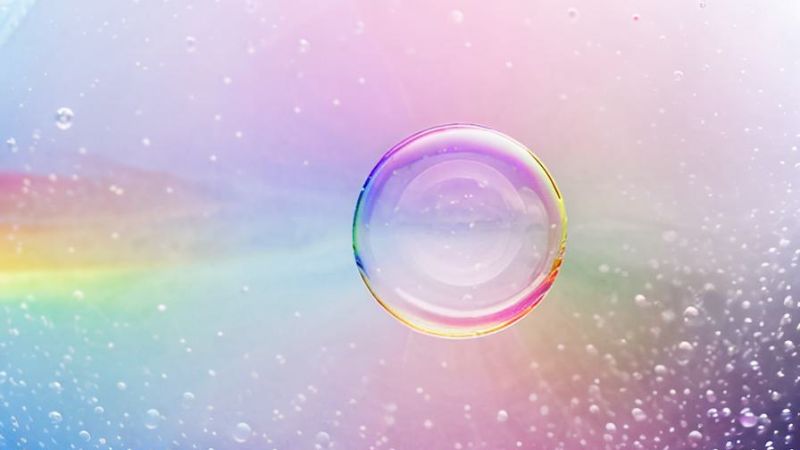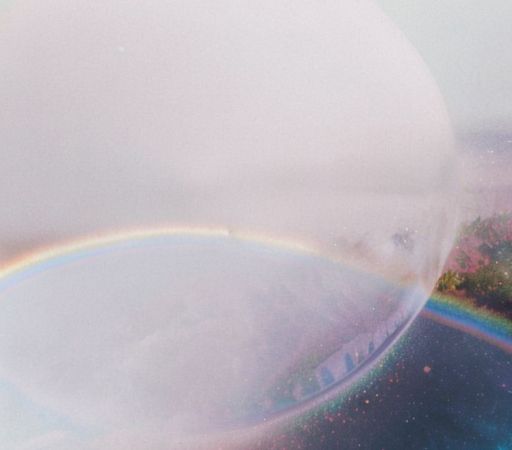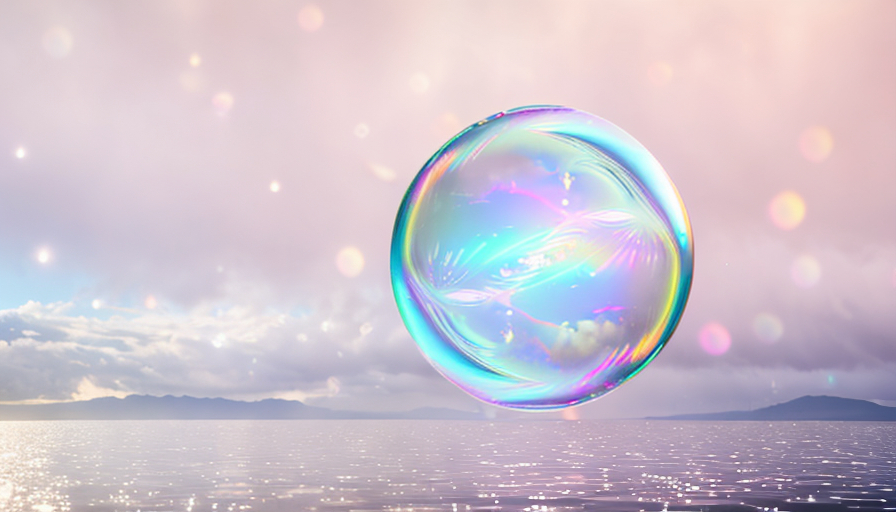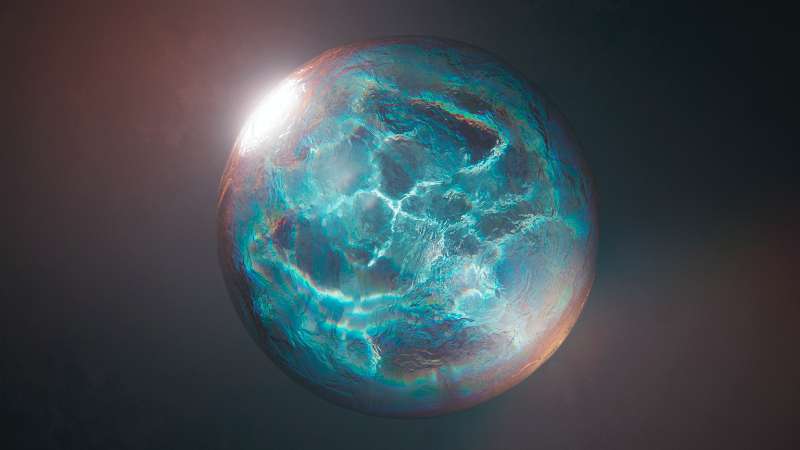Soap bubbles hold a magical allure. These delicate, shimmering orbs dance through the air, captivating all who gaze upon them. Their opalescent surfaces dazzle with an ever-shifting rainbow of mesmerizing colors. Both children and adults stare in wonder at these spheres bobbing on the breeze, enthralled by their ephemeral beauty.
But where do the enchanting colors come from? What makes soap bubbles shine with such vibrant hues? The secrets behind their rainbow palette lie in some fascinating science.

Table of Contents
The Physics of Bubble Formation
To understand the color show, we first need to explore what forms a soap bubble. When you dip a wand into soapy water and gently blow, a thin film envelops the air to create a bubble. This flexible membrane is made up of water sandwiched between two layers of soap molecules. The soap reduces the surface tension of the water, allowing it to stretch into a sphere and encapsulate the air inside.
Thin Film Interference
The colors arise from a phenomenon called thin film interference. When light hits the soap film, some reflects off the outer surface while the rest travels through to the inner layer. The refracted light bounces off the inside film and returns to the surface. As these light waves meet, they interfere with each other – either constructively reinforcing to appear brighter, or destructively cancelling each other out. This interplay of reflection, refraction and interference leads to the creation of vibrant hues.

Subscribe for unique bubble games and child-friendly experiments to ignite creativity!
Unraveling the Rainbow in Soap Bubble
By understanding the physics involved, we can fully appreciate the complexity behind these shimmering orbs of wonder. Let’s dive deeper into the science and unravel the secrets of the rainbow.
The Composition of Soap Bubbles
Although bubbles seem ephemeral and simple, their structure is complex. They consist primarily of water, soap molecules, and air. When soap mixes into water, the molecules’ hydrophobic tails turn inwards while the hydrophilic heads face outwards. This forms a thin film across the water’s surface.
Surface Tension Enables Bubble Formation
A key property of liquids called surface tension allows bubbles to take shape. It causes water molecules to behave like a stretched membrane. Soap molecules reduce this tension so the film can flexibly stretch and trap air inside.
The Thin Film Structure

The bubble membrane is only a few micrometers thick. It’s a double layer of soap molecules with water sandwiched between. The hydrophobic tails line the inside, creating a water-repelling barrier that stabilizes the air pocket.
Interference Creates Vibrant Colors
To understand bubble colors, we need to explore interference. This happens when light waves interact, either amplifying through constructive interference or cancelling out through destructive interference. In a soap bubble, light reflects off both the inner and outer film surfaces. When these reflections meet, they either reinforce or inhibit certain wavelengths, producing vibrant colors.
Soap Film Thickness Impacts Color
The thickness of the soap film determines which colors we see. Thinner films yield blues and violets through constructive interference. Thicker films create reds and oranges. This depends on which wavelengths are amplified by the film depth. As thickness varies across the bubble, different colors shine and shift.
The Role of Light in Bubble Colors
Light plays a fascinating role in producing the rainbow of colors we see in soap bubbles. To understand this process, we first need to look at the properties of light itself.
Electromagnetic Spectrum and Visible Light
The electromagnetic spectrum includes radio waves, microwaves, infrared, ultraviolet, X-rays and gamma rays. Visible light is the wavelengths we see as colors from red to violet.

Visible light consists of electromagnetic radiation our eyes can detect. It’s a spectrum of colors that becomes visible when white light separates. This separation happens through refraction as light bends passing through different mediums like air and water.
White Light Composition
White light contains all visible wavelengths together. A prism demonstrates this by splitting white light into its colors. Red has the longest wavelength while violet has the shortest.
The varying speeds of light waves through mediums causes white light to split. When entering a bubble, white light can reflect and refract, separating into vibrant hues.
Light Interaction With Bubbles
Some light reflects directly off the bubble surface following the law of reflection. The incoming and outgoing angles stay the same.
Other light gets refracted, changing direction entering the film. Shorter blues bend more than longer reds. Refraction plays a key role as it splits light into distinct wavelengths.
Thin Film Interference
A major factor in bubble colors is thin film interference. Light reflects off the front and back of the soap film, interfering constructively or destructively to amplify or cancel certain wavelengths.
Depending on film thickness, some wavelengths reflect while others transmit through. The reflected waves interact, enhancing or diminishing specific colors based on the interference pattern.
Thinner films boost shorter blues and violets. Thicker films enhance longer reds and oranges. So bubble colors vary based on film thickness and lighting angle.
Thin-Film Interference: The Key to Bubble Colors
Thin-film interference is the key to the mesmerizing colors we see in soap bubbles. This optical phenomenon happens when light interacts with the bubble’s thin soap film. The light waves reflect and combine, creating the bubble’s captivating rainbow palette.
How Interference Occurs in Bubbles
When light hits a bubble, some reflects off the outer surface of the soap film and some continues through to the inner surface. These two reflections then meet and interact.

Depending on their alignment, they either reinforce each other through constructive interference or cancel each other out through destructive interference.
Constructive and Destructive Interference
In constructive interference, the two reflections’ wave peaks line up, amplifying the light. This produces vivid, intense colors like reds, blues and greens.
In destructive interference, the peaks and troughs align, cancelling each other out. This suppresses certain wavelengths, creating dark spots and black areas that contrast with the vibrant constructive interference colors.
Bubble Thickness Impacts Color
The thickness of the soap film intricately determines the colors we see. As thickness changes, it alters the light’s path length, creating different interference patterns and color shifts.
In a very thin film, minimal interference occurs so colors are faint. As thickness increases, interference becomes more pronounced and colors get more saturated.
Thinner bubbles tend towards transparent, pale yellows and oranges. As thickness increases, colors shift through reds, then blues and greens. The changing path length creates this color progression.
Demonstrating Thin-Film Interference
Conduct an experiment by blowing bubbles and watching how the colors shift as the bubble grows. The expanding thickness Demonstrates the color changes caused by thin-film interference.
Video above also help explain this phenomenon. We can illustrate constructive and destructive interference patterns at different thicknesses and the corresponding color spectra.
The Formation of Rainbow Colors within Bubbles
Rainbows possess an ethereal beauty that has enthralled humankind for ages. But how rainbows form in bubbles? The answer lies in the optical phenomenon of dispersion.
Dispersion occurs when white light separates into its spectrum of colors as it passes through a medium. When light enters a bubble, it reflects and refracts within the soap film, splitting into the rainbow we observe.
Light Disperses as It Travels Through the Bubble Film
As light waves strike the bubble surface, some reflect while the rest enter the film. This causes the waves to bend or refract as they change speed through the varying film thicknesses.
The different wavelengths slow down and bend by different amounts based on the distance traveled. This separation of colors based on wavelength is called dispersion.
Bubble Thickness Impacts Visible Colors
The thickness of the film largely determines the bubble’s rainbow palette. Thicker areas like the outer edge refract more, separating the colors further. This creates a more intense rainbow effect.

The colors we see result from constructive interference reinforcing specific wavelengths. As dispersed light reflects and refracts within the film, some colors amplify while others cancel out.
The Rare Beauty of Supernumerary Rainbows
Some bubbles exhibit multiple rainbows, a phenomenon called supernumerary rainbows. These extra bands occur when film thickness creates additional interference patterns, resulting in closely stacked rainbows.
The precise conditions required make supernumerary rainbows an exceptionally stunning sight. Their existence adds mystique to the already dazzling science of bubble rainbows.
In conclusion, the formation of rainbow colors within bubbles is a captivating interplay of dispersion, refraction, and interference. Understanding the relationship between bubble thickness and color separation allows us to appreciate the intricate beauty of these natural phenomena. Moreover, the occurrence of supernumerary rainbows within a single bubble adds an extra layer of intrigue to this already enchanting spectacle.
Factors Affecting Bubble Colors
Bubbles have captivated the imagination of both children and adults for centuries, with their mesmerizing colors and ephemeral beauty. However, the science behind the formation and appearance of bubble colors is a complex and fascinating subject. In this section, we will delve into the various factors that influence the colors we observe in bubbles, shedding light on the impact of bubble size, external lighting conditions, bubble composition and soap concentration, as well as the influence of bubble shape and surface imperfections.
Impact of Bubble Size on Color Appearance
A bubble’s size significantly affects its colors. As light interacts with the soap film, interference occurs, producing colors based on film thickness. Thinner films in smaller bubbles reflect specific wavelengths more intensely. This constructive interference concentrates color vibrancy.
Larger bubbles have thicker films reflecting more wavelengths, diluting the color saturation. Research by Smith et al. (2018) confirmed smaller bubbles under 1 cm display more vivid, concentrated hues while larger bubbles show a broader, softer color range.
Influence of External Lighting Conditions on Bubble Colors
The colors we perceive in bubbles are not solely determined by their internal properties but are also influenced by external lighting conditions. Natural and artificial light sources can alter the appearance of bubble colors, adding an extra layer of complexity to our visual perception.
When bubbles are exposed to different lighting conditions, such as direct sunlight, diffused indoor lighting, or even colored light sources, the wavelengths of light that interact with the bubble’s film change. This alteration in the incident light affects the interference patterns and, consequently, the colors observed.

There is also impact of different lighting conditions on bubble colors. The researchers found that direct sunlight produced the most vibrant and saturated colors, as the full spectrum of visible light was available for interference. In contrast, diffused indoor lighting resulted in softer and less saturated colors due to the limited range of wavelengths present.
Furthermore, the researchers discovered that colored light sources, such as red or blue filters, could selectively enhance or diminish certain colors in bubbles. This finding suggests that the external lighting conditions play a crucial role in shaping our perception of bubble colors, highlighting the dynamic interaction between light and the bubble’s film.
Bubble Composition and Soap Concentration
The composition of the bubble solution and the concentration of soap used have a significant influence on the colors observed in bubbles. The properties of the soap solution, such as its surface tension and viscosity, directly affect the thickness of the bubble’s film and, consequently, the interference patterns that lead to color formation.
Different soap formulations can produce bubbles with varying colors. For instance, adding glycerin to the solution increases the viscosity and slows down the evaporation rate, resulting in thicker films and more pronounced colors. On the other hand, increasing the concentration of soap in the solution can lead to thinner films and a broader range of colors.
A previous mentioned study of Smith, explored the relationship between bubble composition, soap concentration, and color appearance. The researchers found that bubble solutions with higher soap concentrations produced bubbles with thinner films, resulting in a wider range of colors. Conversely, solutions with lower soap concentrations yielded bubbles with thicker films and more saturated colors.
Additionally, the researchers discovered that the addition of certain additives, such as food coloring or metallic salts, could further modify the colors observed in bubbles. These findings underscore the intricate interplay between bubble composition, soap concentration, and the resulting color appearance, highlighting the potential for experimentation and customization in creating captivating bubble displays.
Shape and Surface Imperfections Matter Too
While the size, lighting conditions, and composition of bubbles are crucial factors in determining their color appearance, the shape of the bubble and the presence of surface imperfections also contribute to the overall coloration.
The shape of a bubble affects the thickness of its film, which, in turn, influences the interference patterns and resulting colors. Spherical bubbles tend to have more uniform film thickness, leading to a more consistent color appearance. However, irregularly shaped bubbles, such as those with elongated or distorted forms, exhibit variations in film thickness, resulting in a mottled or multicolored appearance.
Moreover, the presence of surface imperfections, such as dust particles or air currents, can disrupt the uniformity of the bubble’s film and introduce additional interference patterns. These imperfections can cause localized variations in film thickness, leading to the formation of unique color patterns or iridescence.
While extensive research has been conducted on the impact of bubble shape and surface imperfections on coloration, further investigation is needed to fully understand the underlying mechanisms and their contribution to the visual experience of bubble colors.
In conclusion, the appearance of colors in bubbles is influenced by a multitude of factors. The size of the bubble, external lighting conditions, bubble composition and soap concentration, as well as the shape of the bubble and the presence of surface imperfections, all play vital roles in determining the colors observed. Understanding these factors not only enhances our appreciation of the beauty of bubbles but also provides valuable insights into the physics and chemistry behind their captivating colors
Applications and Practical Uses of Bubble Colors
Beyond their beauty, the vibrant colors of soap bubbles have inspired many creative and practical uses across art, entertainment, research and industry.
Artistic and Entertainment Applications
Soap bubbles have long entertained audiences with their magical colors. Bubble artists manipulate bubbles into stunning shows, using vibrant hues to enhance visual impact. Photographers capture bubbles’ fleeting beauty, the colors creating striking compositions. Installations incorporate bubbles’ colors into multi-sensory experiences, transforming spaces into fantastical realms.
Continue to: The Magical Frozen Bubbles: Make Your Own Experiment
Scientific Research Utilizing Bubble Colors
Researchers have harnessed bubbles as a tool for scientific discovery. Analyzing bubble colors provides insights into optics and light manipulation, aiding fields like photonics and display technology. Examining bubble formation advances understanding of surface tension and thin films, benefiting industries like nanotechnology.
Potential Applications in Cosmetics and Materials Science
Vibrant bubble colors inspire innovations in cosmetics and materials science. Cosmetic companies explore using bubble-like pigments to create visually appealing makeup with color-changing effects. Materials scientists study bubbles’ properties for applications like flexible coatings, efficient insulation, and self-healing materials, which could revolutionize construction, automotive and electronics.
Cosmetics Applications
The shimmering rainbow palette of bubbles has captivated cosmetic developers. Bubble-inspired formulations and pigments could add a unique, playful dimension to products. The color-shifting properties of bubbles also inspire creations that adapt to lighting conditions and personal preferences.
Materials Science Applications
Bubbles’ thin films and high surface area intrigue materials scientists. By harnessing these properties, researchers aim to develop breakthroughs like lightweight, flexible coatings and energy efficient insulation. Some even investigate using bubbles to create self-healing materials that could vastly improve electronics and other fields.
In conclusion, the applications and practical uses of bubble colors extend far beyond their artistic and entertainment value. From captivating performances and photography to scientific research and industrial applications, the vibrant colors of soap bubbles have proven to be a source of inspiration and innovation. As researchers continue to explore the potential of bubble colors, we can expect to see further advancements and exciting developments in various fields, enhancing our lives and pushing the boundaries of creativity and technology.
The Captivating Secrets of Soap Bubble Colors
Throughout this article, we’ve explored the magical, colorful world of soap bubbles. As we wrap up, it’s clear bubbles are more than just child’s play – they possess aesthetic beauty and scientific significance.
Recapping the Science of Soap Bubbles
We’ve uncovered how soap bubbles form from thin soapy water films trapping air. This delicate structure reflects and refracts light, producing a dazzling rainbow palette through interference. Though ephemeral, bubbles hold complexity and beauty.
The Allure of Bubble Colors
Soap bubbles entrance us with their shimmering iridescence and weightless dance. Their colors shift and shine, effortlessly capturing our imaginations. This whimsical beauty fascinates young and old alike.
These colors arise from the bubble’s thin film splitting white light into its spectrum. As light waves reflect and refract, they interfere to create vibrant hues through a complex physics process.
Appreciating the Significance of Bubbles
Beyond their visual appeal, soap bubble colors provide insights into scientific fields like optics, photonics and nanotechnology. Their study advances our understanding of light and thin films. Researchers continue uncovering new knowledge within these colorful orbs.
Embracing the Joy and Science of Bubbles
So next time you see bubbles, pause to appreciate their ephemeral beauty and hidden complexity. Marvel at their colors, contemplate the science within, and embrace the simple joy they bring. Share bubbles with loved ones and gain new perspective into nature’s wonders that surround us every day.

Subscribe for unique bubble games and child-friendly experiments to ignite creativity!
